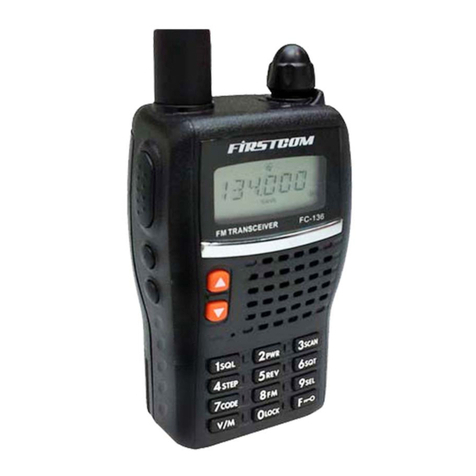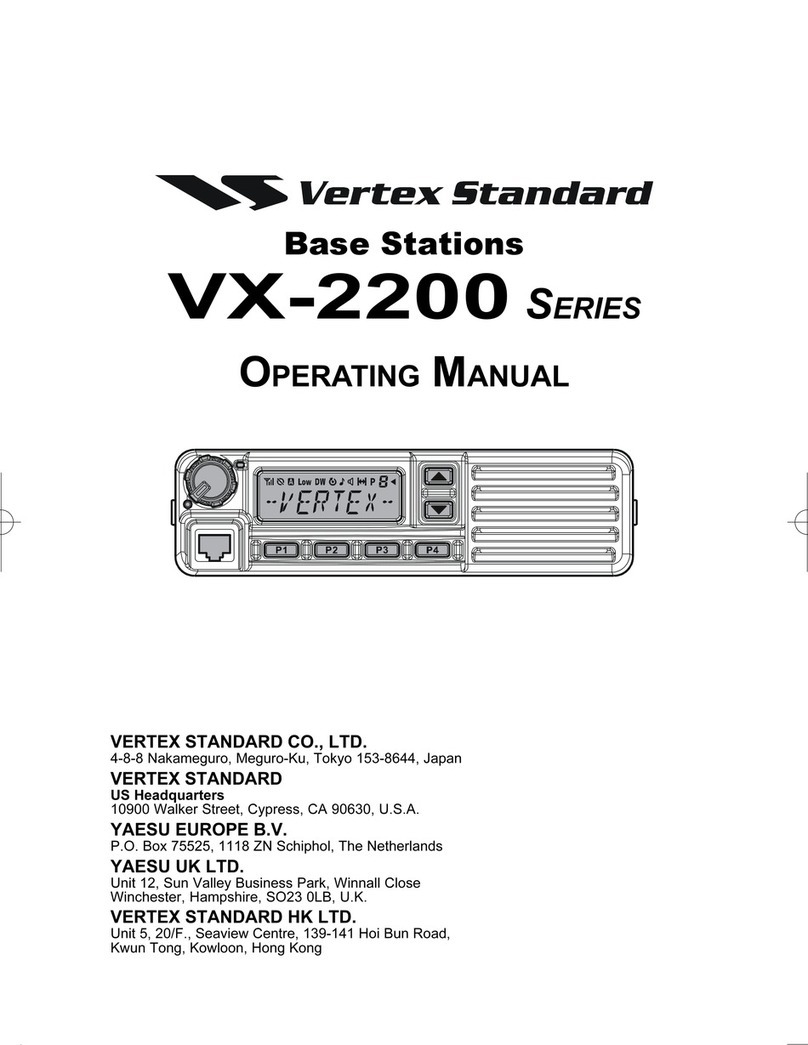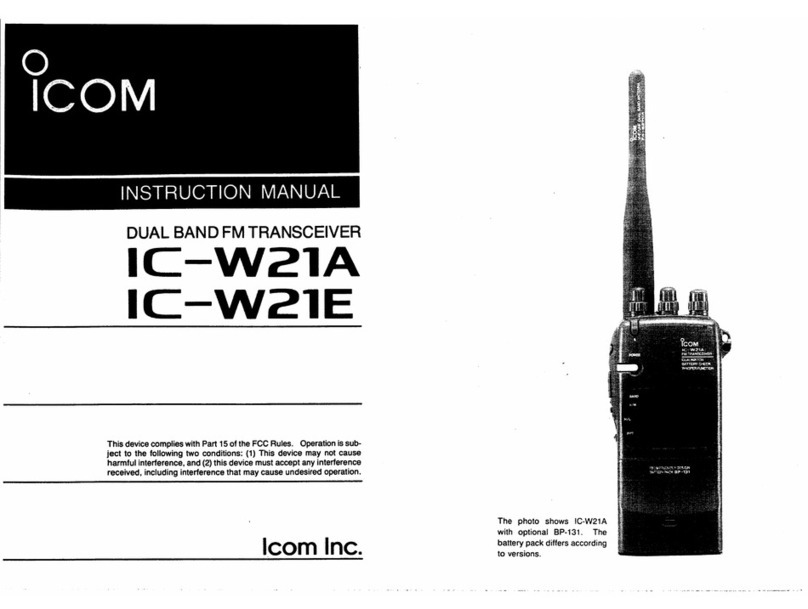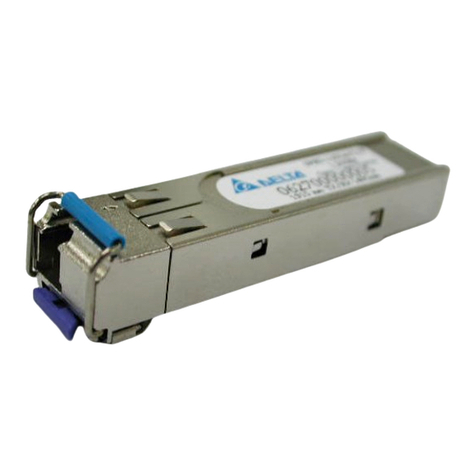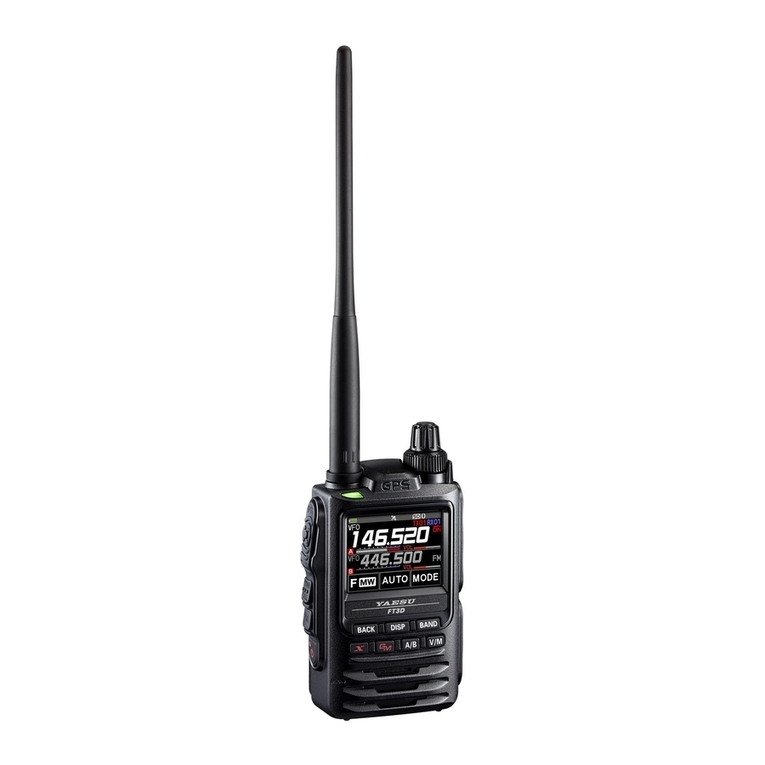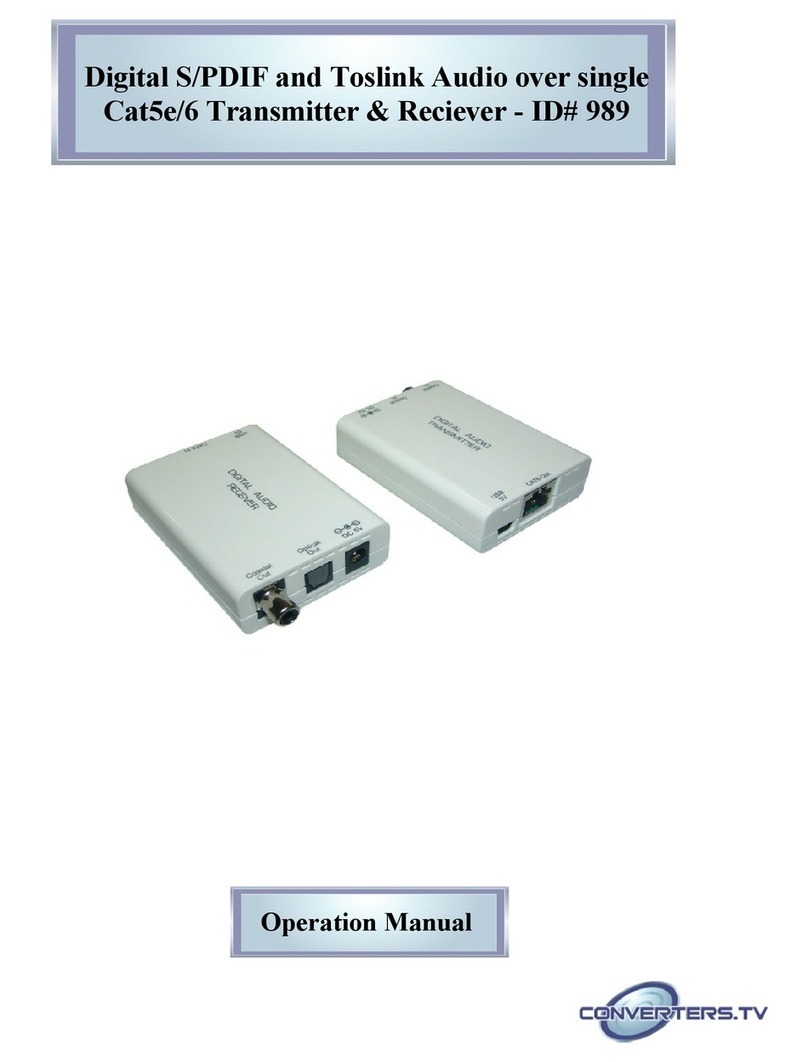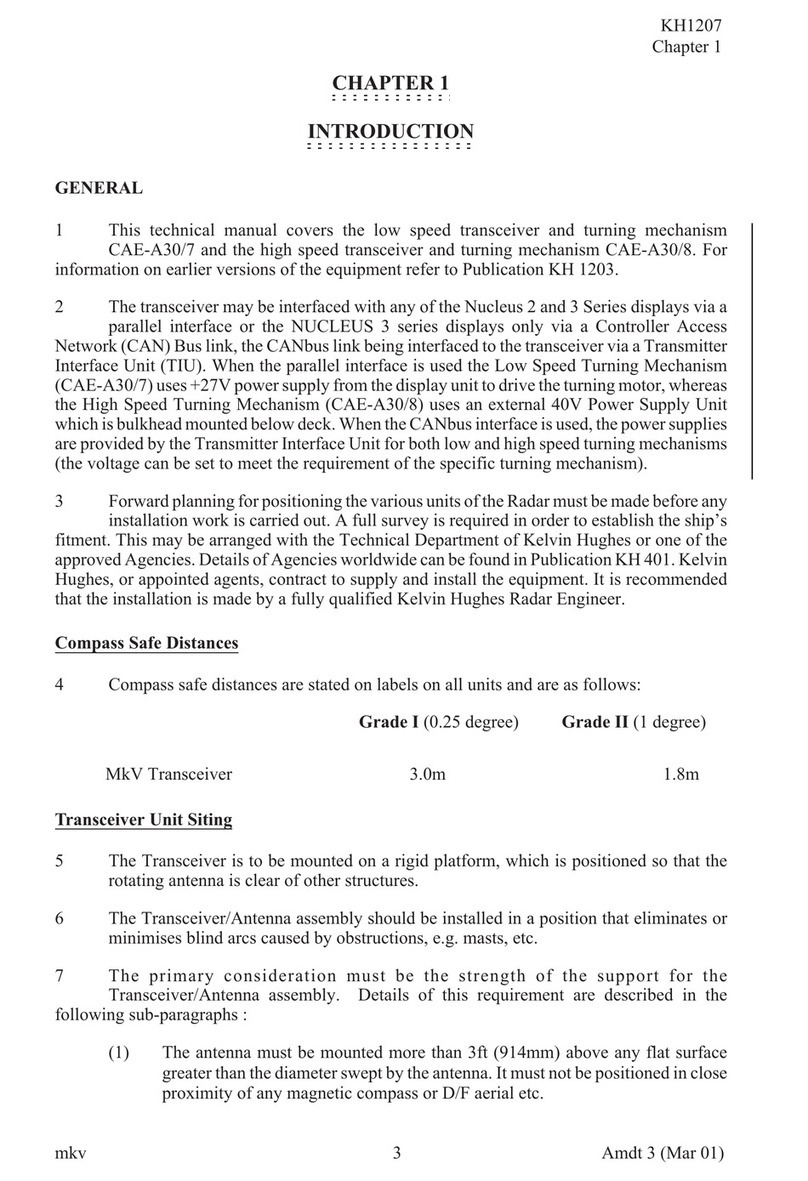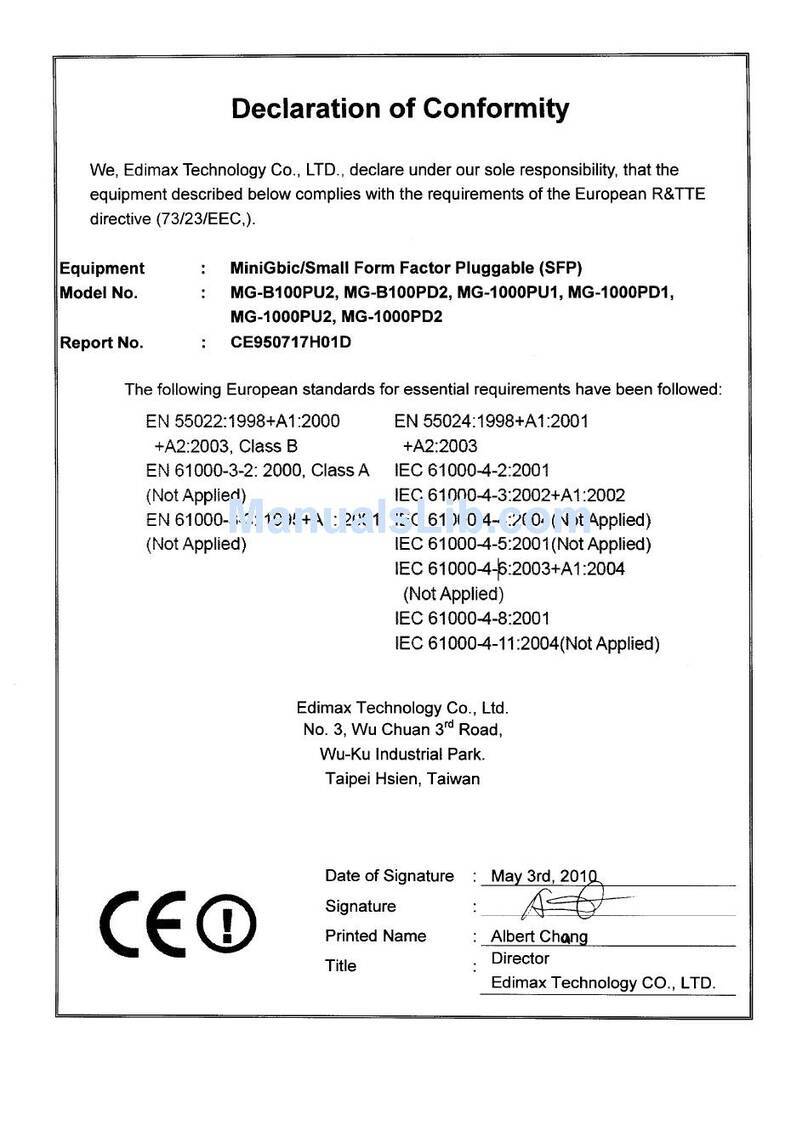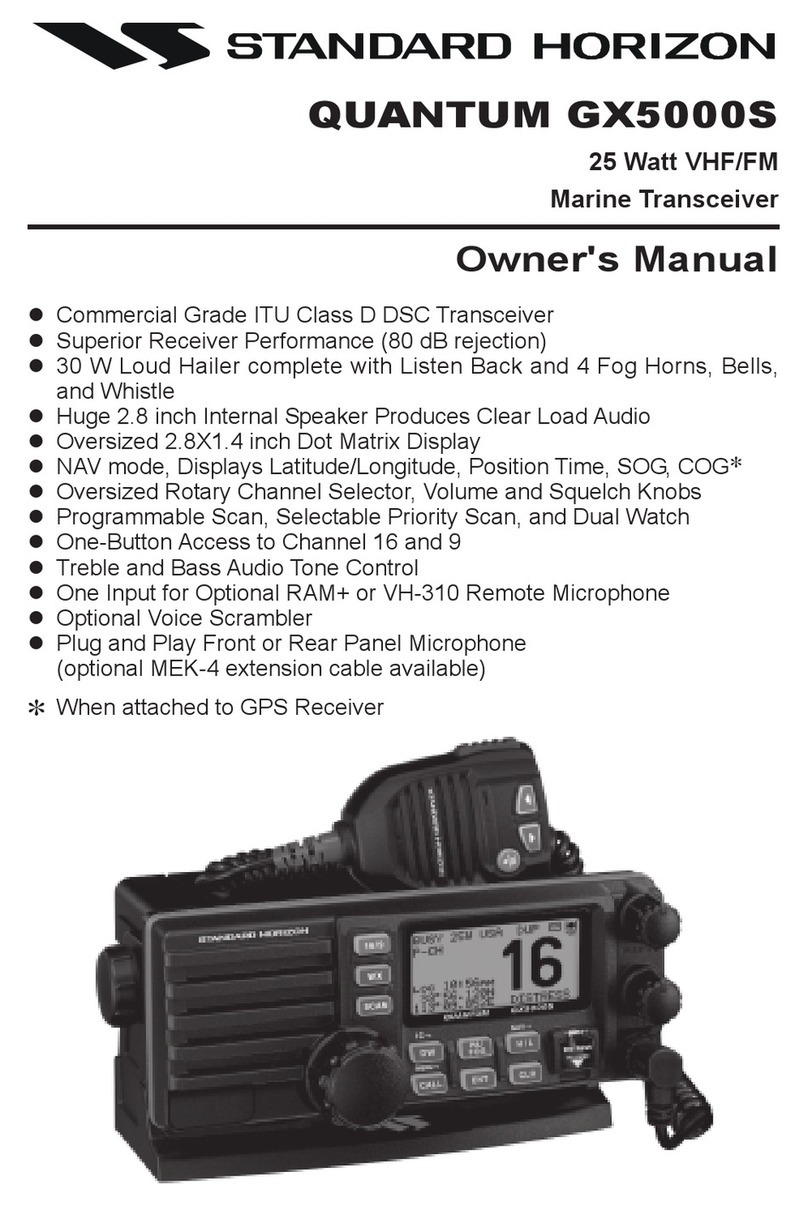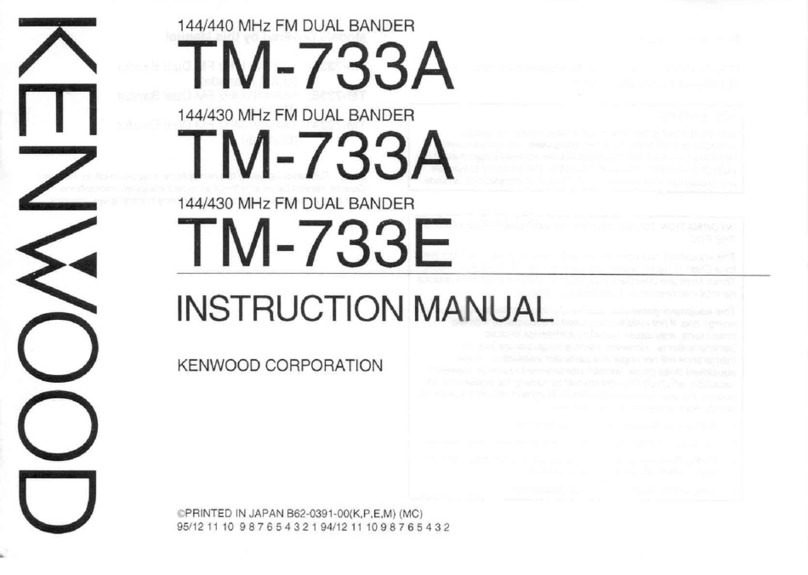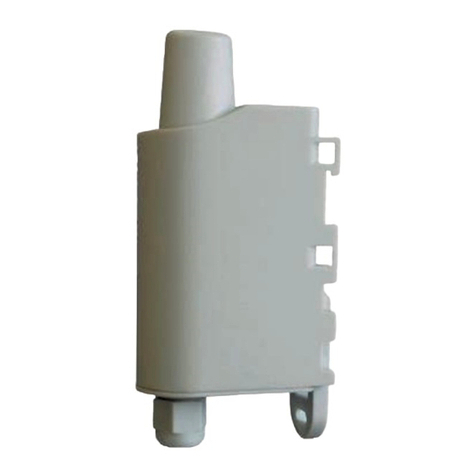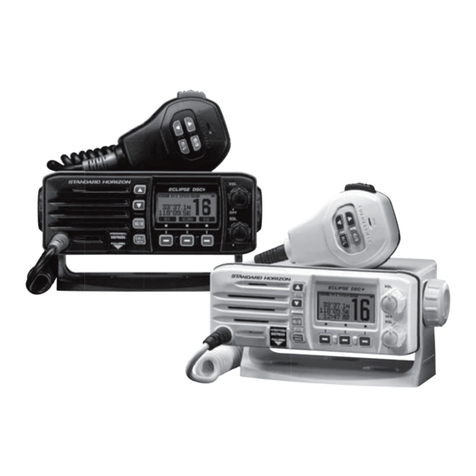Firstcom FR-488 User manual

488
FM MOB ILE TRANS CEIVER
FM MOB ILE TRANS CEIVER
200 Programmed Channel
CTCSS/DCS/2TONE/5TONE
DTMF-ANI/5TONE-ANI
Compander
Three Colors LCD Display
USER’S MANUAL


We only do best radio!
Nice Housing, Stoutness & Stability, Advanced and Reliable functions, Perfect
& Valuable. Approval. FR-488 mobile radio especially designs for
drivers and it pursues company philosophy of innovation and practicality.
NOTE
When programming the transceiver, read the factory initial data rstly, then rewrite the frequency and signaling etc.,
otherwise errors may occur because of different frequency band etc..
Models Apply To This Manual:
FIRSTCOM-488
Mobile radio
FIRSTCOM-488 Mobile Radio Applicable Software: FR488

Thank you for choosing this vehicle transceiver,
always provides high quality products, And this transceiver is no
exception. As you learn how to use this transceiver, you will find that
is pursuing "user friendliness". For example, each time you
change the menu no. in Menu mode, you will see a text message on the
display that lets you know what you are conguring.
Though friendly design for user, this transceiver is technically
complicated and some features may be new to you. Consider this
manual to be a personal tutorial from the designers,allow the manual to
guide you through the learning process now, then act as a reference in
the coming years.
Do not attempt to configure your transceiver while driving,it is
dangerous.
This transceiver is designed for a 13.8V DC power supply. Don't use
a 24V battery to power on the transceiver.
Do not place the transceiver in excessively dusty, humid or wet
areas, nor unstable surfaces.
Please keep it away from interferential
devices (such as TV, generator etc.)
Do not expose the transceiver to long
periods of direct sunlight nor place it close
to heating appliances.
If an abnormal odor or smoke is detected
coming from the transceiver, turn OFF the
power immediately. Contact an Anytone
service station or your dealer.
Do not transmit with high output power for extended periods; the
transceiver may overheat.
Please observe the following precautions to prevent fire, personal
injury, or transceiver damage:
Precautions

CONTENTS
New and Innovative Features..............................................1
Supplied Accessories/Optional Accessories.....................2
Supplied Accessories....................................................................... 2
Optional Accessories .......................................................................2
Initial Installation ..................................................................3
Mobile Installation ............................................................................3
DC Power Cable Connection ...........................................................4
Power Supply Voltage Display ......................................................... 6
Antenna Connection ........................................................................6
Accessories Connections.................................................................7
Getting Acquainted ..............................................................8
Front panel....................................................................................... 8
Rear panel .......................................................................................9
Display .............................................................................................9
Microphone ......................................................................................10
Working Mode(Amateur Transceiver or Professional
Transceiver)
........................................................................11
Basic Operations .................................................................12
Switching the Power On/Off ............................................................ 12
Adjusting the Volume ...................................................................... 12
Switch between VFO and Channel mode .......................................12
Adjusting Frequency/Channel Through Selector Knob.................... 12
Receiving .........................................................................................12
Transmitting .....................................................................................12
Transmitting Tone-Pulse ..................................................................13
Transmitting Optional Signaling ......................................................13
Channel Edit ....................................................................................13
Channel Delete ................................................................................13
Shortcut Operations.............................................................14
Squelch Off/Squelch Off Momentary................................................14
Squelch Level Setup ........................................................................14
Frequency/Channel Scan ................................................................14
Channel Scan ..................................................................................14
CTCSS/DCS Encode and Decode Setup ........................................14
CTCSS Scan....................................................................................15
DCS Scan ........................................................................................15
High/Mid/Low Power Switch ............................................................ 15
Compander (Decrease the background noise and enhance audio
clarity ..................................................................................................15
Offset Direction and Offset Frequency Setup .................................. 16
Keypad Lockout ...............................................................................16
Current Voltage Enquiry...................................................................16
Auto-Dialer Setup.............................................................................16
Transmitting Edited DTMF Tones in the Auto-dialer Memory........... 17
General Setting.....................................................................18
Frequency Channel Step Setup....................................................... 18
DTMF, DTMF ANI, 2Tone or 5Tone Signaling .................................. 18
Sending 2-Tone Call......................................................................... 19
Sending 5-Tone Call......................................................................... 19
Sending DTMF call ..........................................................................19
Signaling Combination Setup...........................................................19

CONTENTS
HIGH/MID/LOW Power Selection .................................................... 20
Band-width Selection .......................................................................20
TX OFF Setup.................................................................................. 21
Busy Channel Lockout .....................................................................21
Editing Channel Name .....................................................................21
Reverse TX/RX ................................................................................ 21
Talk Around ......................................................................................22
Voice Compander ...........................................................................22
Scrambler Setup (Encryption).......................................................... 22
Radio's DTMF SELF ID ENQUIRY .................................................22
Radio's 5TONE SELF ID ENQUIRY ............................................... 23
Voice Prompt....................................................................................23
TOT (Time-out timer) .......................................................................23
APO (Auto power off)....................................................................... 23
DTMF Transmitting Time..................................................................24
Squelch Level Setup ........................................................................24
Scan Dwell Time Setup....................................................................24
LCD Backlight Colors....................................................................... 24
LCD Backlight ..................................................................................25
Pilot Frequency ................................................................................ 25
Display Mode Setup......................................................................... 25
PIN Setup ........................................................................................25
Address List ....................................................................................26
Factory Default.................................................................................26
Microphone Operation .........................................................27
Function Setup By Microphone Keypad...........................................27
Squelch Level ..................................................................................27
Optional Signaling ........................................................................... 27
Scan Skip ........................................................................................ 28
Frequency/Channel Scan ...............................................................28
Busy Channel Lockout .....................................................................28
Reverse TX/RX ................................................................................ 28
TOT (Time-out timer)........................................................................29
CTCSS/DCS Encode and Decode...................................................29
Talk Around ..................................................................................... 29
Voice Prompt....................................................................................29
HIGH/MID/LOW Power Selection .................................................... 29
LCD Backlight .................................................................................30
Long-distance Anti-theft Alarm ..........................................31
Cable Clone ..........................................................................32
Programming Software Installing and Starting (in windows
XP system) ............................................................................33
Maintenance..........................................................................34
Default Setting after Resetting(VHF) ...............................................34
Default Setting after Resetting(UHF) ...............................................34
Trouble Shooting..............................................................................34
Specications .......................................................................35
Attached Chart......................................................................36
50 groups CTCSS Tone Frequency(Hz) ..........................................36
1024 groups DCS Code................................................................... 36

1
1
New and Innovative Features
FR-488 Mobile Radio has nice housing, stoutness & stability, advanced and reliable functions, perfect & valuable. This amateur mobile radio especially
designs for drivers and it pursues company philosophy of innovation and practicality. More functions as follows:
Display on a large LCD with adjustable brightness, convenient for nighttime use.
There are Amateur operation mode and Professional
operation mode for option.
Distribute buttons reasonably, convenient for operation. Adopt superior quality material, better technology and high quality radiator to ensure
stable and durable operation.
200 programmable memorized channels, identied by editing name.
Programming different CTCSS, DCS, 2Tone, 5Tone in per channel, rejecting extra calling from other radios.
Various scan functions including CTCSS/DCS Scan function.
Using
5Tone to send Message, Emergency alarm, Call all, ANI, Remotely kill, Remotely Waken, etc.
Automatic
calling Identication function by DTMF--ANI or 5Tone--ANI .
Scramble function (Optional).
Compander function for decrease the background noise and
enhance audio clarity, it can set compander ON/OFF per channel.
Different band width per channel,
25K for wide band, 20K for middle band ,or 12.5K for narrow band.
Theft alarm provides extra safety.

2
2Supplied Accessories/Optional Accessories
Supplied Accessories
Optional Accessories
After carefully unpacking the transceiver, identify the items listed in the table below. We suggest you keep the box and packaging.
Transceiver
Spare Fuses
[QF-01](15A)
Cloning Cable (CP50)
Desktop
Microphone
(QDM-01)
Alarm Cable A
[QL-01(A)]
Alarm Cable B (Extension line)
[QL-01(B)]
Car Antenna
(QCA-01)
USB Programming
Cable (PC50)
Cigar-Plug Connection
Line (QCC-01)
Programming Software
(FR488)
Regulated Power
Supply (QRP-01)
External Speaker
(SP-01)
User Manual
Microphone (QHM-03)
(with DTMF keyboard)
Mobile Mounting
Bracket (QMB-01)
DC Power Cable with
Fuse Holder(QPL-01)
Hardware Kit for Bracket
Black screws
(M4X8mm)
4PCS(QSS-01A)
Tapping screws
(M5X8mm)
4PCS(QSS-01B)
S-Washer
4PCS(QSS-01D)

3
To install the transceiver, select a safe, convenient location inside your
vehicle that minimizes danger to your passengers and yourself while the
vehicle is in motion. Consider installing the unit at an appropriate position
so that knees or legs will not strike it during sudden braking of your
vehicle. Try to pick a well ventilated location that is shielded from direct
sunlight.
Install the mounting bracket in the vehicle using the supplied self-
1.
tapping screws (4pcs) and at washers (4pcs).
Position the transceiver, then insert and tighten the supplied
2.
hexagon SEMS screws.
Double check that all screws are tightened to prevent vehicle
vibration from loosening the bracket or transceiver.
3
Car body
Washer (M5)
Tapping screw
(M5x20mm)
Mounting bracket
Initial Installation
Mobile installation Determine the appropriate angle of the transceiver, using the 3 screw
hole positions on the side of the mounting bracket.

4
Connect the DC power cable to the transceiver's power supply
6.
connector.
Press
the connectors rmly together until the locking tab clicks.
If the ignition-key on/off feature is desired(optional feature),use the
3
Red
Black
Ext. Power jack
DC power cable
Initial Installation
DC Power Cable Connection
Mobile Operation
In many cars,the cigar-lighter plug is always powered. If this is the case, you
cannot use it for the ignition key on/off function.
The vehicle battery must have a nominal rating of 12V. Never
connect the transceiver to a 24V battery. Be sure to use a 12V
vehicle battery that has sufficient current capacity. If the current
to the transceiver is insufficient, the display may darken during
transmission, or transmitting output power may drop excessively.
When the ignition key is turned to ACC or ON(Start) position with
7.
the radio turned off, the power switch illuminates. The illumination
will be turned off when the ignition key is turned to the off position.
Route the DC power cable supplied with the transceiver directly
1.
to the vehicle's battery terminals using the shortest path from the
transceiver.
We recommend you do not use the cigarette lighter socket as
some
cigarette lighter sockets introduce an unacceptable voltage drop.
The entire length of the cable must be dressed so it is isolated from
heat, moisture, and the engine secondary (high voltage) ignition
system/ cables.
After installing cable, in order to avoid the risk of damp, please
2.
use heat-resistant tap to tie together with fuse box. Don't forget to
reinforce whole cable.
In order to avoid the risk of short circuit, please cut down
3.
connection with negative (-) of battery, then connect with radio.
Confirm the correct polarity of the connections, then attach the
4.
power cable to the battery terminals; red connects to the positive (+)
terminal and black connects to the negative (-) terminal.
Use the full length of the cable without cutting off excess even if
the
cable is longer than required. In particular, never remove the fuse
holders from the cable.
Reconnect any wiring removed from the negative terminal.
5.
optional QCC-01(For Cigar-Plug connection) cable. Connect one of
the cables between the ACC terminal or a Cigar-Plug that operates
with the vehicle ignition or ACC switch on the vehicle and EXT
POWER jack on the rear side of the unit.
Locate the power input connector as close to the transceiver as possible.

5
3
Red
Black
Regulated power supply (QRP-01)
DC power cable with fuse holder (QPL-01)
Regulated
power supply
(QRP-01)
Ext. Power jack
ACC terminal
Cigar-Plug connection
Initial Installation
Before connecting the DC power to the transceiver, be sure to switch
the transceiver and the DC power supply OFF.
Do not plug the DC power supply into an AC outlet until you make all
connections.
In order to use this transceiver for xed station operation, you will
need a separate 13.8V DC power supply (not included) , power
supply( QRP-01) as optional accessories. Please contact local dealer
to require.
The recommended current capacity of your power supply is 12A.
Connect the DC power cable to the regulated DC power supply
1.
and ensure that the polarities are correct. (Red: positive, Black:
negative).
Do not directly connect the transceiver to an AC outlet.
Use the supplied DC power cable to connect the transceiver to a
regulated power supply.
Do not substitute a cable with smaller gauge wires.
To turn on the unit, press the power switch manually while it is
illuminated. (While ignition key is at ACC or ON position)
When the ignition key is turned to ACC or ON position with the
8.
radio's power switch on, the unit turns on automatically and the
power switch will be lit. Turn the ignition key to OFF position or
manually turn the power switch off to shut down the radio.
Using extra cable,power consumption:
9. 5mAh.
Without this function,user can turn on/off radio by Power knob.
10.
Connect the transceiver's DC power connector to the connector
2. on
the DC power cable.
Press the connectors rmly together until the locking tab clicks
.
Fixed Station Operation

6
3Initial Installation
REPLACING FUSES
If the fuse blows, determine the cause, then correct the problem.
After the problem is resolved, replace the fuse. If newly installed fuses
continue to blow, disconnect the power cable and contact your autho-
rized dealer or an authorized servi-center for
assistance.
Only use fuses of the specified type and rating, otherwise the
transceiver could be damaged.
After connecting the transceiver to the power supply, the supply voltage
can be displayed on LCD by pressing the FUN key together with the
key.
The display immediately changes as the voltage supply changes, It
also displays voltage during transmission.
The transceiver will return to its normal operation when the power is
switched ON or repeat above operation.
Before operating, install an efcient, well-tuned antenna. The success
of your installation will depend largely on the type of antenna and its
correct installation. The transceiver can give excellent results if the
antenna system and its installation are given careful attention.
Use a 50Ω impedance antenna and low-loss coaxial feed-line that
has a characteristic impedance of 50 Ω, to match the transceiver input
impedance. Coupling the antenna to the transceiver via feed-lines having
an impedance other than 50Ω reduces the efficiency of the antenna
system and can cause interference to nearby broadcast television
receivers, radio receivers, and other electronic equipment.
Fuse Location Fuse Current Rating
Transceiver 15A
Supplied Accessory DC
power cable 20A
If you use the transceiver for a long period when the vehicle battery is
not fully charged, or when the engine is OFF, the battery may become
discharged, and will not have sufcient reserves to start the vehicle. Avoid
using the transceiver in these conditions.
The range of displayed voltage is only from 7V to16V DC, because the
displayed value is estimated, please use a voltmeter when a more precise
reading is desired.
Power supply voltage Display
Antenna Connection
Important
Transmitting without first connecting an antenna or other matched
load may damage the transceiver. Always connect the antenna to the
transceiver before transmitting.
All xed stations should be equipped with a lightning arrester to reduce
the risk of re, electric shock, and transceiver damage.
The possible locations of antenna on a car are shown as following:

7
3
SP-01
SP-01 Ground
Microphone
connector
Microphone [QHM-03] Antenna
[QCA-01]
External speaker [SP-01]
Error
Initial Installation
External Speaker
Microphone
PC Connecting
If you plan to use an external speaker, choose a speaker with an
impedance of 8 Ω. The external speaker jack accepts a 3.5 mm (1/8")
mono (2-conductor) plug.
For voice communications, connect a microphone equipped with
an 8-pin modular plug into the modular socket on the front of the
main unit. Press rmly on the plug until the locking tab clicks. Attach
the supplied microphone hanger in an appropriate location using the
screws included in the screw set.
To utilize the optional FR488 software, you must rst connect the
transceiver to your PC then using an optional programming cable
PC50 (via Data socket ).
Please use FR488 software for programming.
External speaker adopt double port BTL, please care about the connecting
way. The speaker can not connect with the ground, otherwise the speaker
will be fault. The wrong connecting way as the following picture.
Ask your dealer about purchasing a Programming Cable PC50.
Accessories Connections

8
4
NO. KEY FUNCTION
1Pow(Power) Power On/Off
2VOL Adjust Volume Key
3Main Dial Change frequency, memory channel and scan
direction etc.
4FUN/SET Function Key
5V/M/MW Switches between VFO mode and Channel
mode
6MHz/SHIFT Step Size Key ( step:1MHz)
7TS/DCS/LOCK Sets CTCSS and DCS value
8CAL/H/L Call key
9SQL/D Squelch off
10 Data Terminal Data reading/writing, cloning and theft alarm
functions
11 TX lights during Transmitting
12 Mic.connector Microphone connection port
NO. KEY FUNCTION
4FUN/SET Conrms the selective functions and exit
5V/M/MW Stores data into channels
6MHz/SHIFT Sets offset direction and offset frequency
7TS/DCS/LOCK Sets Keypad lock function
8CAL/ H/L
Switches between HI, MID and LOW power
transmission
9SQL/D Compander mode on/off
NO. KEY FUNCTION
1PWR Reset to factory default settings
5V/M/MW Erase the memory
6MHz/SHIFT Switches between Wide/ Narrow band
7TS/DCS/LOCK Auto dialer
8CAL/H/L
Enters clone data function mode
9SQL/D Enters power supply voltage indication mode
NO. KEY FUNCTION
4FUN/SET Press and hold for 2s to enter the Setting
mode
9SQL/D Monitor mode
Getting Acquainted
Front panel Press key until icon appears then press the following
key.
Press key and following key together to activate
following function:
Functions that require continuous pressing following key
to be activated
Basic Functions

9
4
21
NO. KEY FUNCTION
1Ext. Power
Jack
Terminal for connecting optional cable QCC01 for
use with ignition key On/Off function.
The radio will auto power on when car is driving.
The radio will auto power off when car stops.
2Ext.Speaker
Terminal Terminal for optional external speaker SP01
3Antenna
Connector Connection for 50Ω coaxial cable and antenna.
NO. KEY
Å
FUNCTION
1 SQL Squelch level.
2 MIn channel mode.
3 Indicates the channel number in channel mode.
4Decimal point
Channel skip.
5Decimal point Indicates the decimal point of frequency and the
scanning function.
6 Indicates the frequency or memory name.
7Signal is being received or monitor.
8Signal strength of receiving and transmitting.
9Compander.
10 Keypad lock .
11 DCS Set DCS function.
12 Set CTCSS function.
13 + _Offset frequency direction.
14 Scramble.
15 A Auto power off.
16 Nar Narrow band.
17 LO Low power.
18 Mi Middle Power.
19 Pressing key.
3
Getting Acquainted
DISPLAY
Rear panel
3
1
2
13 10
11
12
14
4567
8
9
15
16
17
18
19 13

10
4
NO. KEY FUNCTION
1UP Increase frequency ,channel number or setting value.
2DOWN Decrease frequency, channel number or setting value.
3PTT Press the PTT (Push-TO-Talk) key to transmit.
4Number Key Input VFO frequency or DTMF dial out etc..
5DTMF ON/
OFF Switches between DTMF dialing or function operating.
6LOCK Switch Locks out the UP 、Down、Numerical keys and Function
keys.
7MIC Speak here during transmission.
Key Pad Serial Data
+5V
DOWN
UP
MIC GND
MIC
PTT
GND
microphone MIC Connector Diagram(in the front view of connector)
Getting Acquainted

11
5
According to practical application,you can set the radio works as
Amateur Transceiver mode or Professional Transceiver mode . There
are also 2 levels operation menu to set functions as you need. It is easy
and convenient (From No.1 to No. 15 are channel function setup,From
No.15 to No.29 are general setting setup).
1.
In PC software's "General
Setting"menu ,choose "Display Mode" to select Amateur
Transceiver mode or Professional Transceiver mode.
:Please refer to "Display Mode" in Page 25.
2. Except setting as "CH" mode, others
considered as Amateur transceiver mode. Under this mode,press
key to switch between Channel mode and VFO mode .
Professional Transceiver Mode
3. When
set display mode as "CH",it enters
into Professional Transceiver mode.At
this mode,except scan,other shortcut
operation can't operate.And from No.1-
17 menu in function setting will be
auto-hidden,They should be set by
PC software.If there is corresponding
name for current channel,the LCD
will display current channel name
Otherwise,it shows current channel number. (As pic 4) (As pic 5)
Under every mode, from No. 18-29 menu in
4. general setting can be
changed and saved.
VFO Mode(Frequency mode)C. :
This mode shows only frequency
on the display. Shortcut operation
and Channel setting will be
changed & stored as the latest
value permanently.Once the radio is
turned off or changed to new VFO frequency, the latest setting is
remained until next change.(As pic 3)
If transceiver programmed as professional transceiver mode and
locked,you can't return to amateur transceiver mode by manual
operation from general setting.
(Pic 1)
(Pic 2)
(Pic 4)
(Pic 5)
Frequency + Channel modeA. : When set display as"FR",it enters
into Frequency+Channel mode, new
setting of channel operation and
shortcut operation can be temporarily
used by user. Once the radio is
turned off or switched to another
channel, the temporary setting will be
erased and back to initial settings.(As pic 1)
Channel+Name Tag ModeB. : When set display as "NM",it enters
into Channel +Name Tag mode. At this mode, it will display
corresponding channel name when
the current channel is edited with
name. Otherwise, it will display
frequency + channel. Its operations
are the same as frequency + channel
mode.(As pic 2)
(Pic 3)
WORKING MODE (AMATEUR TRANSCEIVER OR PROFESSIONAL TRANSCEIVER)

12
In standby, press key or Microphone's
key until appear , this indicates current
channel in channel mode. Repeat above
6
PWR KEY
Dial
Frequency
decrease
Frequency
increase
Volume Knob
Min
Volume
Max
Volume
Basic Operations
Switching The Power On/Off
Adjusting The Volume
Switch between VFO and Channel mode
Adjusting Frequency/Channel THROUGH SELECTOR KNOB
Receiving
according to the option selected during
installation Press the switch or turn the
ignition key to ACC (speed up) or ON (startup)
position to power on radio . Press the key
for 1s or turn the ignition key to OFF position
to turn off.
When the channel you are operating is
called, the screen shows and field
intensity, in this way, you can hear the calling
from transmitting party.
Under frequency (VFO) mode, you can
1.
change the current frequency to the
desired one through selector knob; Turn
clockwise to increase frequency; turn
counterclockwise to decrease. Every
gear will increase or decrease one step.
Press key, the decimal point of
Turn the VOL knob clockwise to increase
the audio level, counterclockwise to decrease.
During communication, volume can be adjusted more accurate.
5k, 6.25k, 8.33K,10k, 12.5k, 20k, 25k, 30k and 50k total nine step size
available for this radio.
If the transceiver has set at higher squelch level, it may fail to hear the calling.
operation to switch between Frequency mode
(VFO) and Channel mode.
frequency in screen will be auto-hidden. In this status, turn selector
knob or Microphone [ / ] key will increase or decrease
frequency quickly by 1MHz step .
Under channel mode, you can change the current channel to the
2.
desired one through selector knob, clockwise turn to the forward
channel, anticlockwise turn to the backward channel. In relative
working mode, Microphone's [ / ] key has same
function for adjusting frequency and channel.
Transmitting
Press and hold key or press MIC's key to monitor for a while
to conrm the channel desired is not busy. Release or press Mic's
key to return standby status,Then press and hold [PTT] key to speak
into microphone.
When the channel you are operating is called,the screen shows BUSY
and field intensity,you can't hear the calling from transmitting party,it
means current channel receives a matching carrier but unmatching
signaling(Refer to CTCSS/DCS encode and decode or Optional Signaling
setup).

13
Basic Operations
Transmitting Tone-Pulse
Transmitting OPTIONAL SIGNALING
Press and hold [PTT] key, then press Microphone [ ] key to
transmit current selected tone-pulse signal.
Press and hold [PTT] key, then press Microphone key or press
key in front panel or press Mic's key to transmit pre-stored and
selected DTMF/2Tone/5Tone optional signaling.
Channel Edit
Channel Delete
Under frequency mode (VFO), turn
1.
selector knob to select the desired
frequency or input frequency by MIC's
numeric keys.
Press
2. key to enter CTCSS/DCS
signaling setup, turn selector knob to
select the desired signaling.
Press
3. key, LCD appears ,
icon and current channel number,
icon ashing means current channel is
Under channel mode, turn selector knob to select channel which
1.
you want to delete.
Press
2. key and key together, current channel will be
deleted and emitted a prompt voice. icon ashing means current
channel is deleted.
empty.
Turn selector knob to select the desired channel number to store.
4.
Press
5. key, , icon and channel number disappears
and emit a prompt voice, thus the channel storage succeed.
6
Press and hold [PTT] key, LED lights RED and power intensity showed in
screen indicates it is transmitting, release to receive.
Please hold the microphone approximately 2.5-5.0cm from your lips
,
and then speak into the microphone in your normal speaking voice to
get best timbre.

14
7Shortcut Operations
Squelch level Setup
Frequency/Channel Scan
Channel Scan
CTCSS/DCS Encode and Decode setup
Setting the radio to a tight squelch level,you can avoid unwanted
signals or noise,but you may not receive a weak signal. Therefore,it will
be better for you to select the normal squelch level.
In frequency (VFO) mode, this function is designed to monitor signal
of every communicative frequency point of transceiver "step size" you
have set.
In channel mode, this function is designed to monitor signal in every
channel.
In channel mode,Press
1. key for 1s to enter into channel scan
Repeatedly press key to check whether
set CTCSS/DCS encode and decode in current
channel or not.
When LCD appears
1. icon, it means
current channel with CTCSS encode,
turn selector knob or press Microphone's
[ / ] key to select desired
CTCSS encode.
When LCD appears
2. and icon,
it means current channel with CTCSS
encode and decode, turn selector knob
or press Microphone's [ / ]
to select desired CTCSS code.
While standby, press
1. key and turn
selector knob until LCD appears
and current squelch level
Turn selector knob or press MIC [
2.
/ ] key to set desired squelch level.
Press any key except
3. and
key to exit .
Frequency Scan
In VFO mode,press
1. for 1s to enter
into frequency scan.
Turn selector knob or press Microphone [
2. / ] key to
change scan direction.
Press any key except
3. and key to exit.
Turn selector knob or press Microphone
2.
[ / ] key to change scan
direction.
Press any key except
3. and key
to exit.
squelch off/squelch off momeNTARY
key programmed as Squelch Off or Squelch Off Momentary to
monitor the weak signal.
Squelch Off: Press
1. key to disable squelch ,press key
again to resume squelch.
Squelch Off Momentary: Press and hold
2. key to disable
squelch,release key to resume squelch.
The above functions should be set in programme software.
Table of contents
Other Firstcom Transceiver manuals
